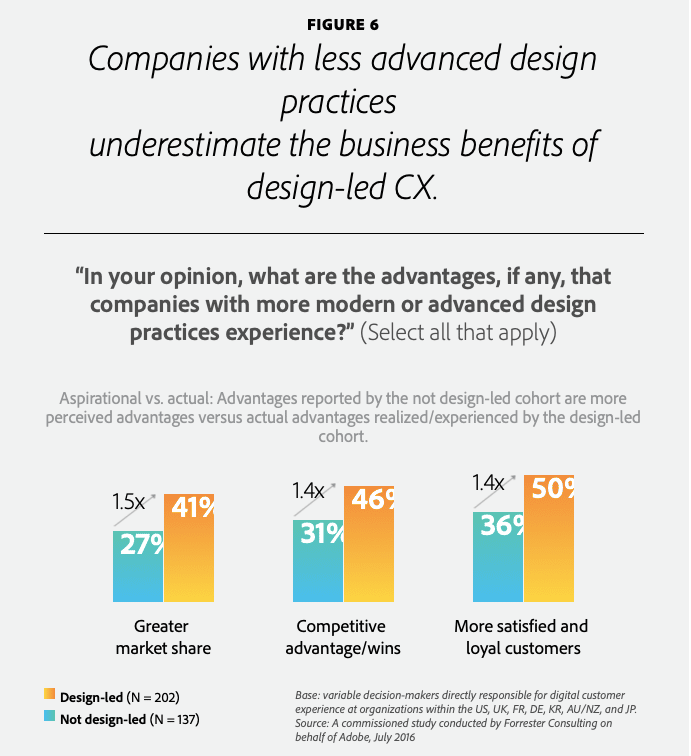A great Customer Experience is the combination of Design Thinking, Agility and the adoption of People Centered Approach. It is an attempt to recognize alternative strategies that might be helpful to us in creative problem solving.
Design Thinking creates a natural flow from research to rollout. The immersion in the Customer Experience produces data, which is transformed into insights that teams will use to create solutions. Assumptions about what’s critical to the success of those solutions are examined and then tested with prototypes and users’ feedback. This process enables innovation and preparation to successfully launch products and services.

According to a study conducted by Forrester Consulting on Adobe’s behalf in 2016, the statistics showed companies that constantly used more modern design thinking practices fared better in customer experience. Understanding your customer with emotional engagement creates a huge value add to the entire customer experience, which is the reason why we decided to propose this learning journey at Business Academia.
It is an unique approach to creative problem-solving. A systematic process and method for organizations to rethink and reframe critical business needs. It is also the use of solution-based thinking, the base of finding a solution to tackle a specific problem. It allows the brain an opportunity to solve problems from a different perspective.
Inspiration
This stage is potentially the most important part of the design thinking process as it lays the foundation for the next two stages. This is about identifying the problems and their scope, where opportunities are discovered and exploration begins. Design thinking combines intuitive and analytical thinking so it requires qualitative data enabling empathy from the customers and quantitative data on the market, competition and main trends.
Some of the common methods used would be conducting focus group surveys, interviews and secondary research. At this stage, it is all about understanding the customer’s needs and challenges. You get inspiration from your target audience or users and you could possibly get your inspiration through conversation or observation. When meaningful data is collected, it gives you better insights on creating the best possible solutions and customer experience.
Ideation
With the design thinking mindset and people centred approach, the goal is to start generating as many ideas as possible and shortlist the potential solutions that you might have for your customers or businesses. At this stage, it is crucial because that is when ideas start flowing in from many new directions.
Brainstorming gets you exploring new ideas for upcoming campaigns or promotions. Eventually, the proposed solutions should be filtered to the best few. There are many methods available for gathering ideas and some of them include Mind Maps, Challenge Assumptions or even Storyboards. There is no “one size fits all” method for every campaign but agility will set your company apart from competitors.
Prototyping
Prototyping is about bringing theory and concepts to life, exploring their real-world impact before finally executing them. This also helps to use your resources more efficiently.
Prototyping is an integral part of design thinking and customer experience because it allows you to test ideas quickly and make improvements in a timely fashion. It might take a number of tries to build an acceptable prototype but the most important thing is that you come out of this phase with something to test – the next possible solution.
Testing
Testing is a good way to see whether your prototypes work as intended. It also involves generating user feedback and from there, gaining a better understanding of your customers.
Testing should be designed with a central question in mind. When done correctly, it may lead to greater insights and even generate new ideas in the ideation stage, changing the way you design a product or service.
Implementation
The first four stages were meant to set the ground for you and your team to find a concept or idea that feels right before moving forward and setting aside resources to build as well as run different prototypes.
Product or service prototypes are built to keep the core design values. In the implementation phase, ideas are converted into solutions leading to a final quality product that can be launched. This is also a good time to create a business model around the concept, making necessary partnerships and preparing your product for real-world use.
Why is it important?Through design thinking, there are many different ways to understand customers. Design thinking is useful when it comes to solving problems or creating lasting value to the customers. Innovation and efficiency are proven benefits from design thinking and it is recommended by most industrial leaders for creating an awesome customer experience.

Improve The Customer Experience
This is another chart from the very same study conducted by Forrester Consulting on Adobe’s behalf in 2016. Again, it shows that design thinking clearly plays a significant role in greater market share, competitive advantages and more satisfied customers. It goes to show that the customer experience is crucial to business growth.
Why? Because design thinking emphasizes heavily on empathy focused approach in businesses and customer experience. Most businesses consider their products through creating enjoyable, relevant, scalable experiences.
Do you wish to tackle the unknown and explore the possible opportunities in your business? Write to us at info@businessacademia.co
Business Academia’s Vision
Our goal is to connect the space between Business Goals, Results and People’s Engagement with consultancy services, tailored experiential workshops and training. We use effective facilitation methods such as Design Thinking to define, together with you, how to engage and motivate people to the desired Change and Action.



